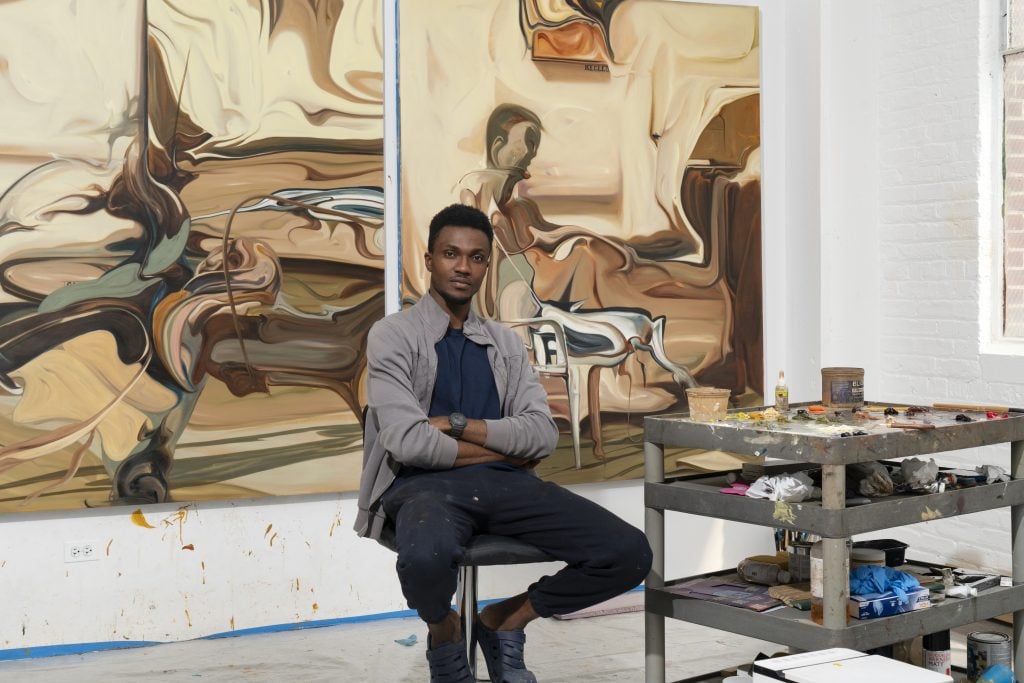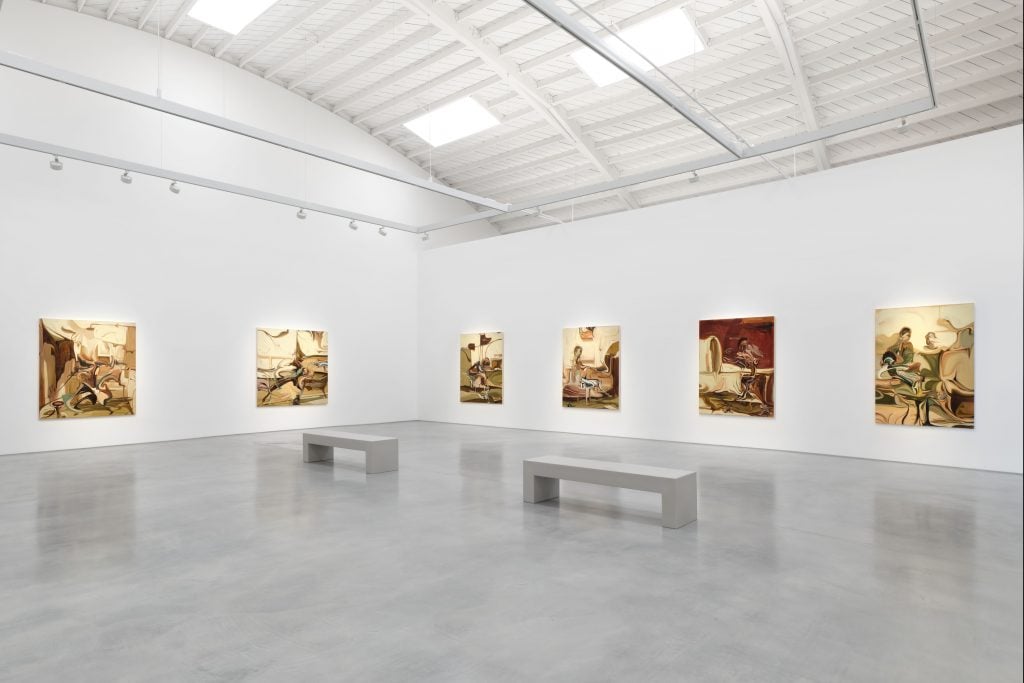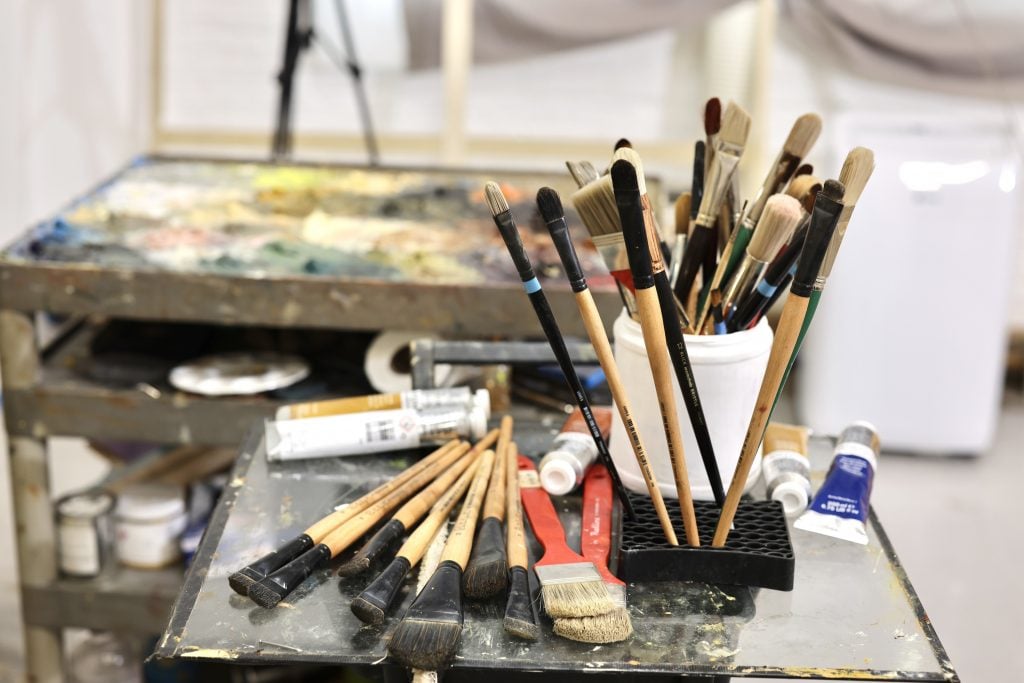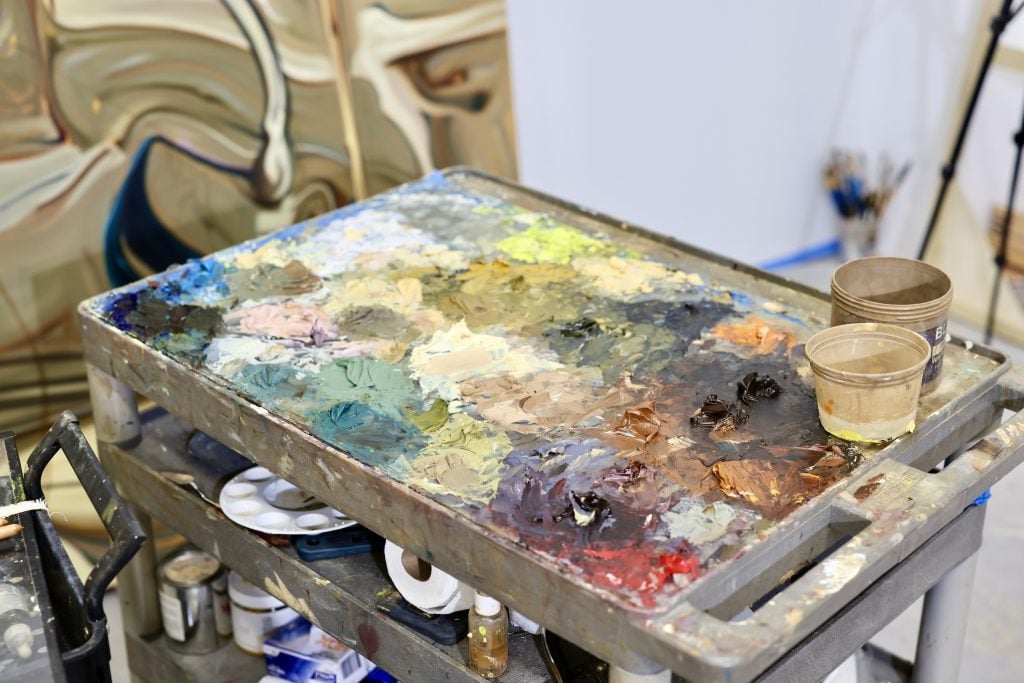Artists
Trendsetting Galleries Are Betting on Rising Artist Luke Agada
Luke Agada's pyschdelic and sinewy new paintings are on view in "Between Two Suns" at Roberts Projects in Los Angeles

In his Chicago studio, Nigerian-born artist Luke Agada gives form to adaptation. His paintings, surrealistic scenes painted in sunburnt hues of rust browns and tans, are elusive and chimerical. In these paintings, figurative beings hover at the threshold of recognizability, tendon-like entities suspended between worlds. Agada admits he’s consumed with visualizing a “Third Space”—a term defined by the Indian writer and scholar Homi Bhabha to describe the place where the two-way influences of the colonizing and the colonized culture meet. These spaces are both physical and psychic, and Agada’s paintings take on the metamorphic ambiguity of memory.

Installation view “Between Two Suns” 2024. Courtesy of Robert Projects, Los Angeles. Photo: Paul Salveson.
He paints these works in his studio in a large 14-story landmark building in the Pilsen neighborhood of Chicago. Now operated by Mana Contemporary, the building was originally a warehouse and garage for Commonwealth Edison’s Fisk Generating station and included a 198-foot-high radio tower “as the communication system to dispatch emergency equipment” he explained. Agada just moved into the space this year, a larger space that has allowed him to scale up with larger square footage, high ceilings, and monumental windows. “The large windows give the space a brilliant influx of natural light,” he added. “The studio has allowed me more space for working comfortably on multiple things all at once. I like to have a fairly organized space when working, that allows me to walk easily around without stepping on or bumping into things.”
His painting process embraces gesturalism and automatism but is also informed by writing, and the thinking of literary, scientific, and socio-political writers is distilled and overlaid in his fluid, shape-shifting scenes. These works have earned him the support of influential galleries. In 2023, opened his first U.S. solo show, Arms, Feet, and Fitful Dreams, with moniquemeloche gallery, who represents him in Chicago. Right now, his first L.A. solo show is on view in “Between Two Suns” at Roberts Projects, (on view through November 2, 2024). Following the opening of the exhibition, the gallery announced they’d be representing Agada on the West Coast. Of the exhibition, Agada said “Living ‘between two suns’ is a constant pursuit of balance that can only be achieved by continuous movement. Nothing is ever really in a state of rest; it’s a law of nature.”
Recently we caught up with Agada at his Chicago studio and dove into his myriad inspirations.
In your new show at Roberts Projects, the work tries to reach a “Third Space” a term defined by writer Homi K. Bhabha. What is this space and how does it manifest in your works?
The “Third Space” is a psychological and conceptual realm, an in-between space where different cultures meet, interact, and give rise to new, hybrid identities and meanings. The Bhabhaian concept of identity as a process of negotiation and transformation is articulated through the adaptation of forms within this space.
The paintings explore the Third Space as a non-representational zone of expression. It eludes structuralist definitions, functioning as a space of ambiguity that resists dominant narratives and challenges binary oppositions such as self/other or colonizer/colonized. This in-between zone is neither wholly one thing nor the other, but a site of fluidity and transformation.
Within my work, it is emerging from the intersection of memory, imagination, and observed reality. I focus on organic and biomorphic forms that sit at the border between the representative and the prefigurative image. These forms inhabit the Third Space, reflecting its capacity to blur boundaries and generate hybrid identities.
I am particularly interested in how this Third Space, situated between globalized constructs of culture, nationality, and other such categories, engenders ambiguous identities within these forms. The inherent instability of the Third Space mirrors a continuous search for balance, as one navigates conflicting cultural expectations, values, and identities. This constant redefinition of self, belonging, and place in the world often leads to feelings of dislocation, ambiguity, and tension.
What other writings have influenced your work?
African literature has also had a profound impact in my work and has served as an early source of inspiration. More recently, the works of the Nigerian novelist Chimamanda Ngozi Adichie. In her book Americanah she delves into themes of identity, displacement, belonging, and the immigrant experience, particularly for Africans in the West, as they navigate their relationship with “home.”

Inside Luke Agada’s studio. Photograph by the artist.
How does your home city of Lagos shape your work? I’m thinking in terms of your color palette, but I’m curious about any other ways as well.
Every city or region in the world has its own unique spectral color effect from the way the sunlight filters through the upper atmosphere due to factors relating to geographical location.
Every city retains a unique color palette, even as light bounces off the landscape of human activities. Lagos, Nigeria, is located close to the equator, which means the sun is typically high in the sky and can appear quite intense, warm, and bright. The sunburnt hue observed on the landscape of Lagos and many other Nigerian cities is one that I have often drawn from because working within that color palette feels close to home.
I believe that our minds interpret memories in colors, and our lived experiences influence the colors of our memories. These colors come together to compose solid forms with different levels of clarity, depending on how vivid these memories are. The parts of the paintings that lack such clear definition are the memories that remain obscure and become that which is almost forgotten.

Luke Agada, Night Sweats (2024). Courtesy of the artist and Roberts Projects.
Your figures in this show are surrealistic, ghostly, even alien, hovering at the limits of recognizability. Tell me about that. How have your figures transformed over time?
At the early stage of my practice, I was strongly influenced by the European surrealists and old masters. Max Ernst, Yves Tanguy, and René Magritte were my most common references. The academy’s approach to figure drawing and painting formed a foundation for me. I began to closely observe the evolution of the human figure depicted in the work of many modernist art movements. The shift in perception, technique, and expression, often challenging traditional representations, became interesting to me as I sought ways to further push the limits of representation without going fully abstract in my work. Yet that did not happen immediately.
When I moved to the United States for my MFA program at SAIC, my process and approach to painting gradually changed due to the change in environment and everything associated with it. The straightforward representation of the human form was not satisfying to me any longer, I was interested in what else was going on around the figure and how the form was responding to the space. I came across the works of Arshile Gorky, Roberto Matta, Willem De Kooning, and other New York school painters. There was something interesting about them that drew my attention. They had this shift and approach to painting that challenged our mundane perceptions of reality and disrupted figuration. Their preoccupation with investing meaning in forms that relate to the whole human experience opened a door to me in my own work and allowed me entry into some of the conversations I was interested in.

Inside Luke Agada’s studio. Photograph by the artist.
What kind of atmosphere do you prefer when you work? Is there anything you like to listen to/watch/read/look at etc. while in the studio for inspiration or as ambient culture?
I mostly like it quiet when I work, because it helps me think and write down thoughts when I need to. But sometimes I listen to podcasts or artist lectures especially when preparing surfaces for painting. I rarely ever listen to music, and if I do it’s often just instrumentals played on repeat to avoid distractions.
When you feel stuck while preparing for a show, how do you get unstuck?
I’ve learned to set aside a painting and move on to something fresh or another work in progress whenever I hit a block. There have been times when I needed to step away from the studio after obsessing over a problem for too long. Often, the best solution is to take a break and focus on something else before returning to it.
What tool or art supply do you enjoy working with the most, and why? Please send us a snap of it. Or is there anything in your studio that a visitor might find surprising?
Over the past two years, I’ve replaced many of my nylon synthetic brushes with bristle ones. They are excellent for moving semi-wet paint around, and I enjoy how they create striking accidental gestures, revealing the underpainting in certain areas of a piece.





